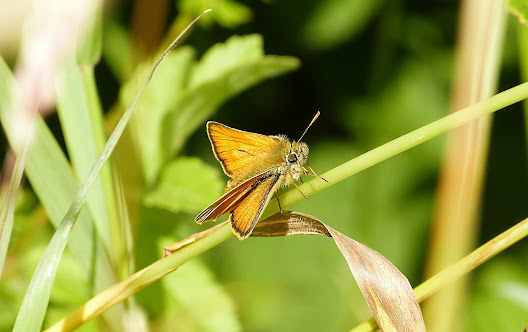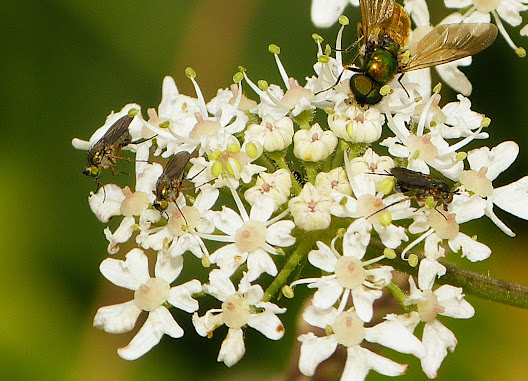Saturday 13th July 2024.
This morning, it turned out to be a ‘red-letter day’ for the moths with SIX excellent ‘year-ticks’. It was cool and clear overnight and I didn't hold much hope for anything exciting, but how wrong I was. In my garden, both Poplar Hawk-moth and Herald moth were present, although the latter species I was very lucky to see as I saw it poking out of the fencing panel. The Poplar Hawk-moth was perched on the outside of the moth box as I quickly grabbed a few photos and put it safely in one of the larger plants nearby. My second Single-dotted Wave of the year was near the box and among the ‘micro’ moths, there was my second Rufous Pearl of the year and an Elderberry Pearl within the moth box. In all, there were 27 moths of 18 species this morning in my garden.
The moths present this morning in my garden included the following:
- Single-dotted Wave
- Double-striped Pug 2
- Poplar Hawk-moth (New For Year)
- Silver Y 5
- Common Rustic 2
- Least Carpet
- Riband Wave 2
- Lackey
- Herald (NFY)
- Garden Carpet
- Common Pug
- Dark Arches 3
- Bird-cherry Ermine
- Elderberry Pearl
- Rosy Tabby
- Rufous Pearl
- Black-banded Masoner
- Blushed Knot-horn
Over at Andy’s Moth trap, the first moth of note seen was a superb Leopard Moth; which was in fact only the second one of this species I have ever seen (the first was over The Oaks Crematorium, Havant). After picking out the likes of Yellow Shell, Uncertain and Common Footman moths with Geoff Farwell, my first Nut-tree Tussock was also found on one of the egg trays. But it got better still when I took the lid of the Moth Box off and inside was my first Pine Hawk-moth of the year and what a beauty it was. Finally, we also found a rather nice micro moth that was also another ‘newby’ for the year, a Blackthorn Knot-horn. The Moths present in Andy’s garden included the following:
- Leopard Moth (NFY)
- Riband Wave 5
- Yellow Shell
- Uncertain
- Nut-tree Tussock (NFY)
- Common Rustic
- Common Footman
- Common Emerald
- Willow Beauty 2
- Pine Hawk-moth (NFY)
- Rosy Tabby 4
- Elderberry Pearl 2
- Blackthorn Knot-horn (NFY)
- Ruddy Streak
- White-banded Grass-moth
After checking the moths, I finished my coffee and enjoyed watching a couple of Nuthatches in Andy’s garden that were perched in a tree behind his garage. The birds then flew off north into a nearby tree. What a great start to the morning and when I told Andy that we were finally taking a drive to Petersfield Lake for the long staying Ruddy Shelduck, it was all systems go for another year-tick!
Petersfield Lake, Petersfield:
Yes, it didn't take long to pick up the Ruddy Shelduck fast asleep on the pontoon, surrounded by Egyptian Geese, a few Mallard and a female Tufted Duck; but hey, its a ‘year-tick’ despite shouts of ‘plastic’ and is it really wild echoing in the background. Nevertheless, it is a smart bird and though you could probably feed it with bread, the bird remained comatosed most of the time, only occasionally popping up briefly if a passing bird got too close. Other birds seen during our walk around the lake included a House Martin overhead, a few Cormorants on some of the islands and a singing Reed Warbler heard somewhere deep within vegetation over on the south-east side.
A few butterflies were on the wing that included a Comma sunning itself, as did a Speckled Wood; both over the south side and a Red Admiral fluttering around on the north side. The waterside plants were impressive though with Purple Loosestrife and Common Ragwort dominant around the edge of the Lake. We even found a Pyramidal Orchid over on the south side. It was a beautiful morning and the lake was looking picturesque, especially looking south with the South Downs in the background.
Old Winchester Hill, Meon Valley:
Andy, Geoff and myself set off for a lovely day's exploration of all things wildlife on Old Winchester Hill and in bright sunshine, we didn't realise whatsoever that the trip here would end in a big soaking from heavy continuous rain. On the positive side, though the birdlife was at times rather quiet, it is a superb site to fall back into insects and plants that adorn this wonderful site. With Geoff’s knowledge on plants, we were picking off some of the specialities that grow here and also marveled at insect life that included our first Dark Green Fritillary of the year and a few interesting moths which also included my first ever Hoary Plume moths of which there were good numbers of them fluttering about near the Fort area.
Of the bird life, raptors seen on our trip here included at least three Red Kites, a Common Buzzard, three Kestrels and a Hobby. The latter was seen when we were watching a pair of Red Kites soaring high near the main road and then a Hobby sailed into view. One of the Kites gave chase briefly, but soon gave up to the lighter more agile falcon. Andy had seen two Kestrels sitting in a small tree and as I took a photo, on closer inspection of the photo, there were actually three birds present!
A few Yellowhammers were seen singing and a few simply flying past and the occasional flock of Linnet would pass overhead. Two Siskins flying over was unexpected and at least two Common Whitethroats were noted. Skylarks were singing around the Fort area and with all this beautiful countryside around us and the spectacular views, what a wonderful place to be. The sun was fairly strong and having applied sunscreen earlier in the car park, we made our way slowly along the footpath enjoying the plants that Geoff was pointing out that included the yellows of Wild Parsnip, Yellow Rattle and thousands of Rough Hawkbit; the purples of Wild Marjoram, Round-headed Rampion and Greater Knapweed and the blues of Harebell, Scabious and Clustered Bellflower.
A wealth of butterflies were noted today that did include our first Dark Green Fritillaries. At least three were seen, but only one rested briefly on a plant before flying off into the distance. Small Tortoiseshells have been very scarce this year so one was seen flying past along the track leading to the Fort while we were having a well earned drink on one of the benches. Other butterflies noted included Large White, Ringlet, Meadow Brown, Small & Essex Skipper, Red Admiral, Marbled White and Gatekeeper.
Sitting on the bench overlooking the Hill looking north by the Fort entrance, we felt the first drops of rain around 2pm. Then the heavens simply opened. We took shelter nearby under a tree, but after half an hour or so, we decided to take the soaking and make our way back to the car. Yep, I got drenched, but it was only rain and so reflected on the way back all the excellent sightings we had today; not only on what we saw on Old Winchester Hill, but some superb quality moths from the Moth Boxes earlier today.











































No comments:
Post a Comment